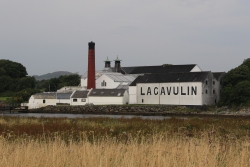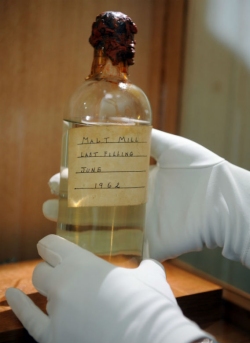
Lagavulin 

Lagavulin is located between Laphraoig and Ardbeg on the southeast coast of Islay. The distillery produces 2,400,000 litres a year for its 16 year old whisky. The shop and visitor centre is an unexpected but pleasant surprise with its tongue-and-groove panelled walls and weathered look. The distillery celebrated its 200th anniversary in 2016.
30% of Lagavulin's output goes into White Horse, a blended whisky. The remaining 70% goes to produce single malts under the Lagavulin name. Lagavulin currently produces a 200th anniversary 8 year old, its usual 16 year old and various other editions including a distiller's edition with 3-6 months finishing in sherry casks.
What Makes Lagavulin £30
The first visit was to Lagavulin and the Distillery Exhibition tour that comprised four twenty minute sessions on the distillery’s history, Diageo’s Port Ellen malting plant, mashing and distillation and finally tasting some of the pre-launch 10yo and the Feis Ile 2019 19yo bottling.

Georgia Crawford gave a talk on the history of Lagavulin and how spirit was first made from surplus grain and used by doctors as a treatment for various ailments. She gave a brief explanation of how the Lagavulin manager fell out with Laphroaig, for whom he was an agent, and started up the Malt Mill distillery on the Lagavulin site in attempt to replicate the Laphroaig spirit. The output from Malt Mill always went into blended spirits, such as White Horse, and there are no known bottles of Malt Mill single malt. Or are there? - have a look here. The Malt Mill distillery closed in 1962 and a bottle of new make spirit exists at Lagavulin, pictured here.
Georgia is on the team that is rebuilding Port Ellen and will be the distillery manager when it opens in 2021.
Sam gave a technical presentation on how the malting factory works, its annual consumption of grain (30,000 tons) and peat (3,000 tons). The factory receives grain from England (preferably) or Scotland and supplies malted barley to seven of the nine distilleries on Islay. Grain arrives at about 12% moisture and it is then steeped to raise this to 40-45%. The barley starts to germinate and after about 95 hours the process is stopped by drying the barley. This is done using hot air for an unpeated barley or in peat smoke until the required phenol level is reached for peated barley. Drying continues until the grain has about 4.5% moisture and then it is ready for sending to the customer distilleries.
Kenny and Craig explained the mashing and distilling operations respectively in session three.
Session four was a tasting of the 2019 Feis Ile expression and the new 10 year old that is yet to be launched. When it is, it will be for travel retail only but expanded for general purchase after about six months. The 2019 Feis Ile is available at £120.